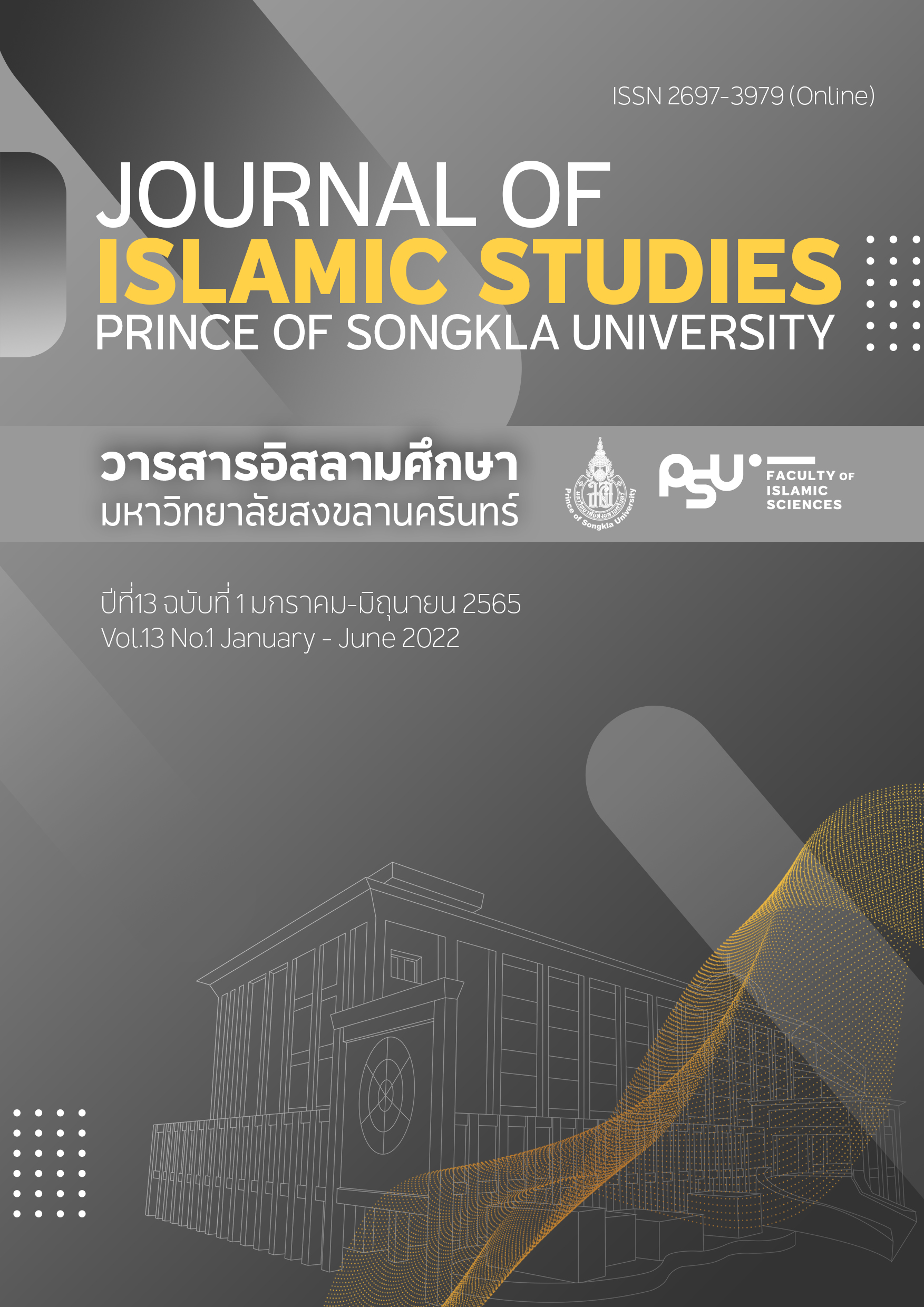บทบาทของครอบครัวมุสลิมต่อความสำเร็จและความล้มเหลวในการบำบัดรักษาผู้ป่วย (ผู้ติดยาเสพติด) กรณีศึกษา สถานบำบัดในพื้นที่จังหวัดปัตตานี
คำสำคัญ:
ครอบครัวมุสลิม, ความสำเร็จ, ความล้มเหลว, การบำบัดรักษาผู้ป่วย, จังหวัดปัตตานีบทคัดย่อ
วัตถุประสงค์ การวิจัยครั้งนี้เป็นการวิจัยเชิงคุณภาพ มีวัตถุประสงค์เพื่อศึกษาบทบาทของครอบครัวมุสลิมต่อความสำเร็จและความล้มเหลวในการบำบัดรักษาผู้ป่วย (ผู้ติดยาเสพติด) กรณีศึกษา สถานบำบัดพื้นที่จังหวัดปัตตานี
วิธีการศึกษา การวิจัยครั้งนี้เป็นการวิจัยเชิงคุณภาพ กลุ่มเป้าหมายที่ใช้เป็นบุคคลที่มีความรู้ และเกี่ยวข้องกับการดำเนินงานการบำบัดรักษา โดยพิจารณาคุณสมบัติผู้ให้ข้อมูลดังนี้ (1.1) ผู้ปกครองหรือญาติพี่น้องของผู้เข้ารับการบำบัด จำนวน 5 คน (1.2) ผู้เข้ารับการบำบัด จำนวน 20 คน (1.3) กลุ่มเจ้าหน้าที่และผู้เชี่ยวชาญด้านยาเสพติด จำนวน 10 คน (1.4) ผู้นำและคณะกรรมการสถานบำบัด จำนวน 5 คน รวมเป็นจำนวน 40 คน และใช้แบบสัมภาษณ์เป็นเครื่องมือในการเก็บรวบรวมข้อมูลในการวิจัย และผู้วิจัยได้นำเสนอผลการวิจัยข้อมูลเชิงพรรณนาความเกี่ยวกับข้อค้นพบ
ผลการศึกษา (1) บทบาทของครอบครัวมุสลิมต่อความสำเร็จในการบำบัดผู้ติดยาเสพติดในพื้นที่จังหวัดปัตตานี พบว่า (1.1) ครอบครัวมีความอบอุ่นสมาชิกในครอบครัวมีการเอาใจใส่ซึ่งกันและกัน (1.2) ผู้ปกครองต้องมีเวลาให้กับสมาชิกในครอบครัว (1.3) การติดตามเอาใจใส่ลูกอย่างใกล้ชิดของผู้ปกครอง (1.4) ความเข้าใจต่อพฤติกรรมของลูกและต้องตักเตือนอย่างสม่ำเสมอ (1.5) การเป็นแบบอย่างที่ของสมาชิกในครอบครัวโดยเฉพาะเรื่องยาเสพติด (1.6) การยึดมั่นในหลักการศาสนา (1.7) การหล่อหลอมขัดเกลาแก่ลูกอย่างต่อเนื่อง โดยเฉพาะการพัฒนาตนเอง การประกอบอาชีพเพื่อลดเวลาว่างแก่ผู้ที่ผ่านการบำบัดรักษา (2) บทบาทของครอบครัวมุสลิมต่อความล้มเหลวในการบำบัดผู้ติดยาเสพติดในพื้นที่จังหวัดปัตตานี พบว่า (2.1) ครอบครัว เช่น การขาดความอบอุ่นจากผู้ปกครองตั้งแต่เด็ก การกีดกันจากพ่อตาแม่ยายจนนำไปสู่ปัญหาการหย่าร้าง การหย่าร้างที่เกิดจากตัวผู้ติดยาเสพติดปิดบังข้อมูลของตนเองแก่ภรรยา ผู้ปกครองไม่ยอมรับความจริงในตัวตนของลูก (2.2) เด็กและเยาวชนขาดการดูแลเอาใส่ใจอย่างใกล้ชิด (2.3) กระบวนการอบรมเลี้ยงดูและการหล่อหลอมที่ไม่ดีนำไปสู่ผลกระทบทางจิตในปัจจุบันได้ (2.4) เวลาในการดูแลผ่านการบำบัดซึ่งผู้ปกครองไม่มีเวลาในการดูแลเป็นสาเหตุสำคัญในการจูงใจกระตุ้นให้เกิดการใช้ยาเสพติดเพื่อระบายความกดดันที่เกิดขึ้นกับตนเองนำไปสู่การใช้ยาเสพติดได้ (2.5) การตั้งความหวังต่อผู้ผ่านการบำบัดมากเกินไปทำให้เกิดแรงกดดันได้
การนำผลวิจัยไปใช้ เมื่อทราบถึงบทบาทของครอบครัวมุสลิมต่อความสำเร็จและความล้มเหลวของสถาบันครอบครัวมุสลิมจะเป็นประโยชน์อย่างยิ่งต่อสถานบำบัดรักษาผู้ที่ติดยาเสพติดและครอบครัวของผู้ที่ผ่านการบำบัดรักษาฯ ในการนำองค์ความรู้จากการวิจัยไปใช้ในการป้องกันการติดยาเสพติดซ้ำในกลุ่มของเด็กและเยาวชนและครอบครัวได้ และหน่วยงานที่เกี่ยวข้องสามารถนำองค์ความรู้ดังกล่าวไปเติมเต็มกระบวนการบำบัดยาเสพติดเพื่อเพิ่มศักยภาพกระบวนการบำบัดรักษาผู้ติดยาเสพติดให้เกิดผลสำเร็จได้มากยิ่งขึ้น
References
Chaipichitphan, N. (2015). Development of a Rehabilitation Therapy Model in Amphetamine Addicted Patients. Action Participation. Thammasat University.
Digital Research Information Center. (1986). Factors Affecting Narcotics Offenses by Thai Muslim Offenders in the Four Southern Border Provinces. (Master Of Arts Program In Criminology And Criminal Justice). Mahidol University.
Duangtham, R. (2004). Process for Solving Stress Problem of Nurses in Drug Dependence Treatment Center of Northern Thailand. (Master Of Education Program). Chiang Mai University.
Emawattana, T. (2002). Counseling Psychology for Drug Addicts. Thamma sat University.
Emawattana, T. (2005). Counseling Psychology for Drug Practitioners. 2nd Edition. Thammasat Book Center.
Hamon, E. (2018). The Success of Community in Protection and Solution of Problem of Youth Risking To Drug Addition in Angthong Province. Journal of Mcu Nakhondhat, 5(2), 434-451.
Enactment drug law (No. 8). (2021) (2021, November 8). Government Gazette, 138(73), 81.
Enactment drug law (special). (1979) (1979, April 27). Government Gazette, 96(63), 40.
Friedman, M. M., Bowen, V. R., & Jones, E. G. (2003). Family Nursing Theory and Practice (5th Ed.). Upper Saddle River.
Hanpattanachaikun, K. et al. (2007). A Study of Drug and Substance Addiction Recurrence Undergoing Treatment at Thanyarak Institute and Drug Treatment Center, Provincial Region 4 Centers. Khon Kaen Nana wittaya Printing Plant.
Hanpatchaiyakul, K. et al. (2007). The Relapsing of Drug Addiction Patients at Thunyarak Institute and the Regional Drug Dependence Treatment Center. Klungnana Vitthaya Press.
Kawin, P. & Senanuch, P. (2018). Personal Factors, Society Factors And Knowledge Level Related To Causes And Behaviors Of Taking 4x100 Drug Type, Among Children And Youth In The Venue Of Youth Observation And Protection In Zone 8 And 9. Journal of Social Work, 26(2), 205-233.
Krainatee, M., Dhammasaccakarn, W., & Sungkharat, U. (2020). Family: The Social Key Institutions and Roles of Holistic Human Development. Parichart Journal Thaksin University, 33(1), 1-16.
Mungkung, W., Wacharasin, C., & Deoisres W. (2016). Family Factors Influencing Substance Abuse In Male Adolescents At A Juvenile Vocational Training Centre. The Public Health Journal of Burapha University, 11(2), 53-63. (In Thai)
Manipakorn, P. (2010). Criminology and Penology. (2nd Printing). M.T.Press.
Narcotics Control Technology Center. (2012). Treatment and follow-up. (Online). Available: https://nctc.oncb.go.Th/ Main.Php?Filename =Index
Jitsawang, N., & Jailek, S. (2001) Route of Inmates in Drug cases. Department of Corrections and the Bureau of Narcotics Prevention and Suppression.
Office of Narcotics Control Board. (2019). Drug Situation in the Lower Southern Region. (Online). Available: https://www.oncb.go.th/ oncb_or9/picture/forms/thumbnails.aspx.
Office of the Narcotics Control Board. (2017). Drug Prevention and Solution Action Plan 2017. Ministry Of Justice.
Office of the Narcotics Control Board. (2017). The situation of drug problem area 7 Lower Southern Provinces, october 2016 – March 2017. (Online). Available: https://www.Oncb.Go.Th/ Oncb_Or9 /Picture.
Princess Mother National Institute on Druq Abuse Treatment. (2012). Family Education Group Outpatient Drug Addiction Treatment According to the Cognitive-Behavioral Therapy Model. Department Of Medical Services.
Phuphaiboon, R. (1998). Family Nursing: Theoretical Perspectives and Application. VJ Printing.
Pranee, S. (2017). Factors Affecting Success in Drug Addiction Treatment: A Case Study of Drug Addiction Rehabilitation Center Lat Lum Kaeo District Pathum Thani Province.College of Government Rangsit University.
Sangsong, S, Uthis, P., & Suktrakul, U. (2019) The Effect Of Multidimensional Family Therapy Program On Amphetamine Consumption In Adolescent With Amphetamine Dependence, The Journal Of Psychiatric Nursing And Mental Health, 33(2), 76-90.
Supawong, A. (2016). The Effectiveness of Modified Matrix Program Drug Treatment of Thungsong Hospital. Songklanagarind Journal of Nursing, 36(Special), 160-170.
Suthisukon, P., Dammee, D., & Sueluerm, K. (2008). The Path to Drug Addiction, Adolescents, School Age. Asean Institute for Health Developement, Mahidol University
Suthisukon, P., Dammee, D., & Sueluerm, K. (2008). The Path to Drug Addiction, Adolescents, School Age. Asean Institute for Health Developement, Mahidol University.
Thongbai, A., & Sripairot, T. (2021). Knowledge on the Prevention and Solution of Important Child and Youth Substance Abuse Problems in Thailand. Center for Addiction Studies (Cads) Prince of Songkla University.
Preechasuchart, W., & et al. (2006). To Study The Factors Affecting Drug Addiction Behavior Of Patients Undergoing Psychosocial Therapy (Matrix Program) In The 3 Southern Border Provinces. Pattani Healing Center.
Wechwithan, P. (2014). Introduction to Family Theory. Pappim.
Wongsamut, N. (2017). The Source Of Drugs Is One Question That The Pattani Soldiers Can't Answer. Date Retrieved 6 June 2019, from https://www.bbc.com/thai/40024683.
Downloads
เผยแพร่แล้ว
How to Cite
ฉบับ
บท
License
Copyright (c) 2022 วารสารอิสลามศึกษา มหาวิทยาลัยสงขลานครินทร์

This work is licensed under a Creative Commons Attribution-NonCommercial-NoDerivatives 4.0 International License.
บทความทุกเรื่อง ที่ได้รับการตีพิมพ์ในวารสารอิสลามศึกษาเป็นแนวคิดของผู้เขียน มิใช่เป็นความคิดเห็นคณะผู้จัดทำและมิใช่ความรับผิดชอบของคณะวิทยาการอิสลาม กองบรรณาธิการไม่สงวนสิทธิ์การคัดลอก แต่ให้มีการอ้างอิงแสดงที่มา





